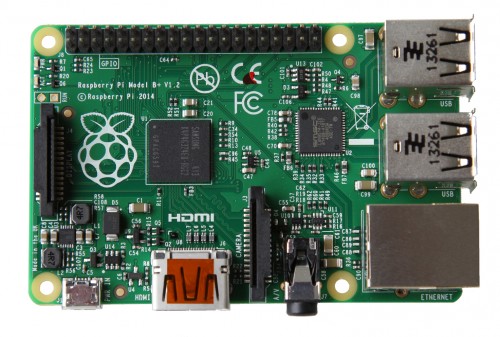From BBC:
A new version of the Raspberry Pi barebones computer has been released.
Called the B+, the updated version uses less power than its predecessors and will cost about $35 (£20).
The B+ can also power more peripherals without the need for a dedicated power source and has more connectors to help link it to other devices.
The new model is released as the Pi faces increasing competition from other tiny computers.
Power train
The B+ is based on the same Broadcom chip as earlier versions and has the same 512 megabytes of memory but a variety of other changes have been made to the device.
The analogue and composite video connector has been ditched in favour of a single four-pole connector and the SD card slot has been replaced with a micro-SD card unit. This has a latch on it to ensure the smaller card does not fall out.
Better power management on the B+ will mean it can keep four USB peripherals going without requiring mains power or an external hub.
"People expect to see four USB ports these days," said Mike Powell, a spokesman for electronics components firm Element 14 which sells the Pi. "With the Model B as soon as you had connected a keyboard and mouse that was it."
More USB ports and better power management allowed owners to run a 2.5in (6.4cm) hard drive off the device without the need for a powered hub, said Mr Powell.
The General Purpose I/O (GPIO) section of the device has also been expanded to 40 pins - 14 more than on the original machine.
This, said Mr Powell would give people many more options to add work with extras such as sensors and relays.
"When the Pi was first launched they really underestimated what people were going to do with it," he said.
Close-up of Raspberry Pi Model B+ About three million Raspberry Pi computers have been sold around the world
In a review of the B+ in Linux Voice Ben Everard said one of the most significant improvements was the gadget's power management. An improved voltage regulator meant the device was much more stable when handling USB-connected peripherals.
"To be able to handle lots more input and output means this is a significantly more useful computer," wrote Mr Everard, "and will be especially important for new users who may not have a great power supply or a powered USB hub."
The B+ will be available via online electronics stores such as Element 14. About three million Raspberry Pi computers have been sold around the world.
The Pi now faces much more competition from devices such as the Beaglebone Black, the Hummingboard, the APC 8750, the Android MK802 mini PC, Banana Pi and the Matrix TBS2910.
http://www.bbc.com/news/technology-28263659
A new version of the Raspberry Pi barebones computer has been released.
Called the B+, the updated version uses less power than its predecessors and will cost about $35 (£20).
The B+ can also power more peripherals without the need for a dedicated power source and has more connectors to help link it to other devices.
The new model is released as the Pi faces increasing competition from other tiny computers.
Power train
The B+ is based on the same Broadcom chip as earlier versions and has the same 512 megabytes of memory but a variety of other changes have been made to the device.
The analogue and composite video connector has been ditched in favour of a single four-pole connector and the SD card slot has been replaced with a micro-SD card unit. This has a latch on it to ensure the smaller card does not fall out.
Better power management on the B+ will mean it can keep four USB peripherals going without requiring mains power or an external hub.
"People expect to see four USB ports these days," said Mike Powell, a spokesman for electronics components firm Element 14 which sells the Pi. "With the Model B as soon as you had connected a keyboard and mouse that was it."
More USB ports and better power management allowed owners to run a 2.5in (6.4cm) hard drive off the device without the need for a powered hub, said Mr Powell.
The General Purpose I/O (GPIO) section of the device has also been expanded to 40 pins - 14 more than on the original machine.
This, said Mr Powell would give people many more options to add work with extras such as sensors and relays.
"When the Pi was first launched they really underestimated what people were going to do with it," he said.
Close-up of Raspberry Pi Model B+ About three million Raspberry Pi computers have been sold around the world
In a review of the B+ in Linux Voice Ben Everard said one of the most significant improvements was the gadget's power management. An improved voltage regulator meant the device was much more stable when handling USB-connected peripherals.
"To be able to handle lots more input and output means this is a significantly more useful computer," wrote Mr Everard, "and will be especially important for new users who may not have a great power supply or a powered USB hub."
The B+ will be available via online electronics stores such as Element 14. About three million Raspberry Pi computers have been sold around the world.
The Pi now faces much more competition from devices such as the Beaglebone Black, the Hummingboard, the APC 8750, the Android MK802 mini PC, Banana Pi and the Matrix TBS2910.
http://www.bbc.com/news/technology-28263659

